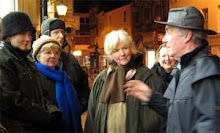
Piggledene is an old Wiltshire name; Piggle or 'Pig-all' refers to the berry of the whitethorn bush, whilst 'Dene' simply means valley.
Piggledene is situated on the A4 between Beckhampton and Marlborough. If you decide to go looking for it, you'd best keep a sharp eye out because it’s dead easy to miss. The only marker is a wooden stile set into the hedgerow that will ultimately, when traversed, lead you into a secret, tranquil valley peppered with periglacial sarsen stones.
Piggledene’s sarsens have been known locally for many years as the Grey Wethers; this may have something to do with their uncanny resemblance to grazing sheep when viewed from a distance, in fact ‘wether’ was an old English name for sheep.
So how did they get there?
Between 50 and 60 million years ago and particularly during the last ice age, water erosion and shifting freezing and thawing ice flows exposed, eroded and broke up this crust of sarsens into millions of loose boulders that remained scattered across the Wiltshire landscape. Many of these massive stones gradually slid down the valley sides, accumulating at the bottom of the slope, those visible today were most probably broken up around two and half million years old. It is most likely that Avebury stone circle, the Neolithic mound of Silbury Hill and the West Kennet Long Barrow were constructed close to this abundant deposit of sarsen stones, not by chance but by design. Silbury hill especially contains many such boulders as well as tonnes of crushed chalk, again abundant in the area.
The boulder-strewn terrain survived until medieval and early modern times. But as agriculture increased and became more intensive, water erosion washed soil from ploughed fields down onto valley bottoms, burying huge numbers of sarsen stones. Many of the remaining rocks were then cleared in order to increase the amount of arable land. As towns developed and grew, large numbers of sarsens were broken up for use as building material, evidence of which can be seen nearby at Beckhampton and Avebury village. Today, only a few small areas are left – notably Fyfield Down, Overton Down, Lockeridge and Piggledene.
Folklore
It is said that the sarsens were perceived by prehistoric man to be the spirits of the dead, their souls preserved in stone in the natural world. They were thought to move, dance, drink and even bleed. The great ‘Diamond Stone’ at Avebury is said to cross the A4361 at an appointed time of the year, no mean feet at 40 tonnes. The sarsen stones which make up the inner ring at Stonehenge are thought to be symbolic markers for the dead, a gigantic 5000 year old open-air mausoleum, complete with a ring of pits called the Aubrey Holes where many cremated human fragments have been unearthed. Silbury Hill is now thought to be a burial mound, not for bodies but for souls, it too contains tonnes of sarsens and chalk. Many cultures throughout the world have strong beliefs that stone has the capacity to hold captive the spirit. In India some believe it possible to be reincarnated in stone. The use of stones to mark the final resting place of a loved one is a tradition we still hold firm today, albeit safe in the knowledge that their souls are not trapped within headstones.
To consider the folklore, not just here in Britain but around the world, may well suggests that the mysterious landscape of ancient Wiltshire may conceivably have been and indeed still is, a spiritual Mecca and an ideal place to construct such impressive monuments. Wiltshire draws thousands of visitors annually, many seeking a certain something, I do hope they find it. I did but then I'm referring to its natual beauty.
The sarsens must have presented prehistoric man with a headache, ney a mystery. Why were so many huge stones strewn across the landscape of Wiltshire, sitting as they did on top of a few meters of soil, gravel and chalk, the geology must not have made sense and that folks, is often how folklore takes a hold.
Piggledene valley is a strange, tranquil place, especially when you think the busy A4is only a few hundred yards away and yet its noise seems barely able to encroach on the peaceful valley floor. Should you visit Piggledene, it is unlikely that you will encounter another soul; some may welcome that - I did. The A4 offers no parking and to walk beside it can be an a nerve-racking experience. But should you persist in your quest then I promise you wont be disappointed. If you sit atop one of its banked sides, as I have and gaze down on the 'Grey Wethers' below, you may start to wonder, nay consider, the tireless dedication required by our ancient forebearers, who, at some point would most likely have quarried stones from this very valley to construct some of the features mentioned earlier.
It is understandable why Piggledene has a reputation for being a ‘spiritual place’, its tranquillity alone promotes such beliefs.






No comments:
Post a Comment